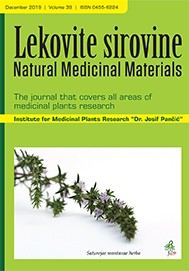Department of Biochemistry, Faculty of Medicine, University of Novi Sad , Novi Sad , Serbia
Department of Biotechnological and Pharmaceutical Engineering, Faculty of Technology, University of Novi Sad , Novi Sad , Serbia
Department of Biotechnological and Pharmaceutical Engineering, Faculty of Technology, University of Novi Sad , Novi Sad , Serbia
Department of Biotechnological and Pharmaceutical Engineering, Faculty of Technology, University of Novi Sad , Novi Sad , Serbia
Department of Biotechnological and Pharmaceutical Engineering, Faculty of Technology, University of Novi Sad , Novi Sad , Serbia
The influence of Satureja montana extracts on several liver biochemical parameters in mice administered with carbon tetrachloride was estimated. In vivo investigation of antioxidant properties of S. montana extracts encompassed monitoring of biochemical parameters (derived from liver homogenate and blood hydrolyzate) and examination of potential hepatoprotective effect after intoxication with carbon tetrachloride. Biochemical tests included determination of activity of several antioxidant enzymes: xanthine oxidase, catalase, peroxidase, glutathione peroxidase, amount of reduced glutathione and intensity of lipid peroxidation. In order to obtain data about the potent hepatoprotective effect of examined extracts, the following parameters were determined: aspartate aminotransferase, alanine aminotransferase, bilirubin, hepatic DNA and hydroxyprolin. Results of this study demonstrate that S. montana extracts inhibited the hepatotoxicity produced by carbon tetrachloride administration most probably through activation of physiological common defense mechanisms.
This is an open access article distributed under the Creative Commons Attribution License which permits unrestricted use, distribution, and reproduction in any medium, provided the original work is properly cited.

The statements, opinions and data contained in the journal are solely those of the individual authors and contributors and not of the publisher and the editor(s). We stay neutral with regard to jurisdictional claims in published maps and institutional affiliations.